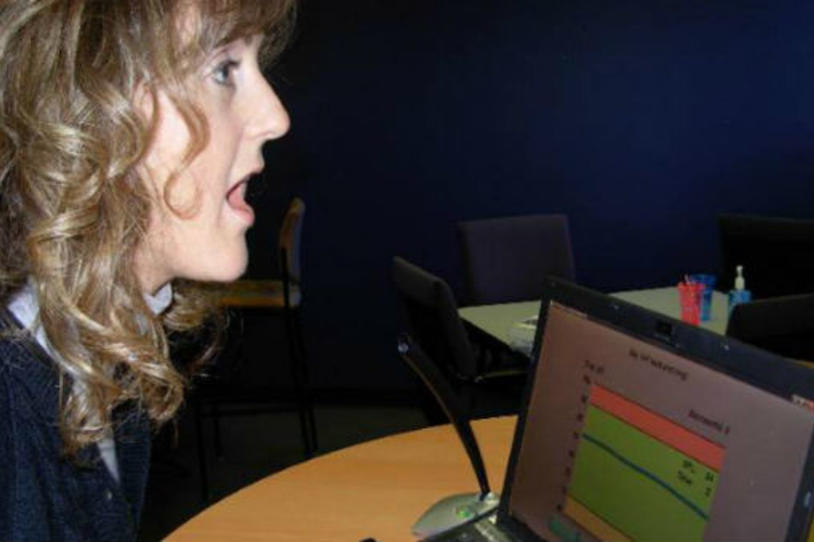
Developer Angela Halpern demonstrates use of the LSVT Companion software.
Recently, Grammy award-winning singer Linda Ronstadt told AARP that she can no longer sing due to Parkinson's disease (PD).
Like Ronstadt, Dr. Ralph Calatchi's voice has been affected by his PD, diagnosed 27 years ago.
“I found that my voice was deteriorating. If you can’t communicate, you are very isolated,” he said.
While almost 90 percent of PD patients experience speech problems, such as reduced volume and pitch range and trouble with articulation, a very small number seek treatment.
“Many times people with Parkinson’s aren’t aware their voice is too soft,” said Angela Halpern, speech pathologist and researcher with the National Center for Voice and Speech. “During interviews they may say no when asked if they have any voice problems, but they’ll report their spouse often asks them to repeat things.”
Halpern was part of a team that created the Lee Silverman Voice Treatment (LSVT) program: “an intensive, one-month speech therapy program that trains individuals with PD to speak in a louder, good-quality voice.” Four times per week over four weeks, patients are taught to speak more loudly by first recognizing their voice is too soft then learning the right amount of effort and loudness required for normal speech (or normal loudness). The repetitive, progressively complex nature of the practice and feedback from the clinician leads to consistent improvement. The LSVT program, developed in the early 1990’s, progresses from practice of single words to short phrases to functional conversational speech.
“We’re trying to recalibrate that sensory perception of normal loudness,” said Halpern.
Simply knowing there’s a problem to address is one barrier to seeking treatment for voice disorders, but other factors like mobility, geography and insurance reimbursement can keep patients from enrolling in the demanding LSVT program. As it is the only speech treatment for PD patients with its level of success, access is particularly important.
“We started looking at technology for a way to make treatment accessible while maintaining the fidelity of the training,” said Dr. Lorraine Ramig, professor at the University of Colorado-Boulder and lead developer of LSVT and a co-founder of LSVT Global.
Funded in part by The Michael J. Fox Foundation, Dr. Ramig and her team created the LSVT Companion: interactive, customized software that provides LSVT training. Researchers from the Unites States, Brazil, Israel and Canada published on the tool’s efficacy in the American Journal of Speech-Language Pathology in November 2012, showing that study participants who used the Companion demonstrated comparable success to those enrolled in the traditional, in-person LSVT program.
All 16 participants in the study had 16 sessions of LSVT: nine conducted in-person, and seven completed at-home with the Companion. The study used personal digital assistants for portability, and trained participants on how to use the at-home software. The Companion group showed significant gains in voice loudness and quality immediately after treatment and at six-month follow-up. Researchers compared these outcomes to those of previous studies of the traditional, 16 in-person LSVT sessions.
Dr. Ralph Calatchi
Dr. Calatchi, who was not enrolled in this study, completed the LSVT program in 2002, but the drawback then was the lack of incentive to practice at home. Now, thanks to the LSVT Companion, he is motivated to keep up the practice. In particular, he likes the feedback feature and the freedom to practice during his frequent travel, he said. “It’s made a huge difference.”
How does the LSVT program lead to lasting functional improvement? Part of it is neuroplasticity – forming new neural connections to compensate for injury or disease – said Dr. Cynthia Fox, co-founder of LSVT Global. “The program has the components that lead to brain change. It’s intensive, it’s repetitive and we’ve built in complexity and progressive difficulty,” she said. “The information also has to be salient. We tailor the content to each individual’s goals and interests.”
The Companion has evolved to PC-based software (with calibrated microphone) that provides feedback and captures data useful for patients and clinicians.
As a tool for clinicians, the Companion can provide validated and reliable voice sound pressure data to monitor a patients’ progress. LSVT Global has recruited Dr. Max Little, Wellcome Trust-MIT postdoctoral fellow and MJFF grantee, to build an algorithm to detect voice quality.
Dr. Ramig views the software as part of the continuum of care, used early in disease or after completion of the LSVT program, to keep one’s voice strong in coordination with in-person or telemedicine consultations.
Patients will always need practice, said Halpern. “It’s an exercise program. If you don’t use it, you lose it.” Regarding continued use, the Companion’s feedback feature is motivating and provides an external measure for monitoring, she said.
“Communication is so important. Without it, people lose their confidence, their sense of self,” Dr. Ramig said. “This program is improving lives, but we find access to treatment a challenge. This technology can broaden our reach and help more people.”
Read more about the Companion and its availability and hear from patients pre- and post- LSVT training at http://www.lsvtglobal.com/.
Read more about MJFF funded research on voice and Parkinson’s.
